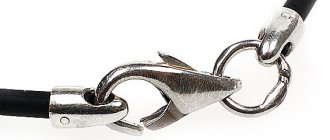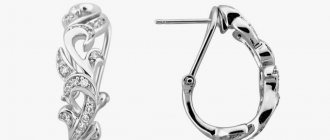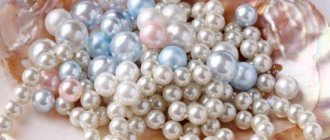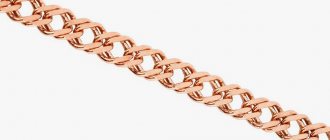English clasp on earrings
An English lock on earrings is a pin in the shape of a nail and a strip of metal with a hole into which the pin is inserted and secured with light pressure due to the presence of a small hook-shaped slot on it. The fact that the lock is locked can be determined by a slight click. To open the clasp, the tip of the pin must be lifted up (unclick the lock).
The advantages of the English clasp include:
- ease of inserting the pin into the ear and fixing it;
- high reliability (cases when an English lock unfastens itself are quite rare);
- comfortable to wear (English clasp does not cling to hair or scratch your neck, even if you fall asleep in it);
- strength (the locking loop is a small hole in a fairly wide and thick strip of metal, and is difficult to deform).
The disadvantages of an English castle include:
- loosening of the fastener with frequent snapping and unfastening;
- decent weight, which makes earrings with such a clasp undesirable for young beauties;
- inability to adjust the length of the pin. If it is short, then the earrings are painful to wear, and if it is long, the heavy stone may outweigh the clasp and be “out of place.”
Earrings with an English clasp are suitable for adult women who lead an active lifestyle, often travel, and go on business trips. It is not advisable to take them off and put them on often, so that the lock does not stop locking. But you can sleep in such earrings, which is very convenient on the road.
Chain
Chains are an elegant, light and neat decoration that is easy to put on and take off. Sometimes they are called earrings without a lock. Their main advantage is that they do not deform over time.
But despite their many advantages, chain earrings always get caught in your hair, which often causes inconvenience.
So, the clasp is an important element of decoration that you need to pay attention to when choosing. Otherwise, the product will cause constant discomfort when wearing and putting on.
29.09.20
Italian clasp on earrings
The Italian clasp on earrings, like the English one, has a pin in the shape of a thin stud stick. However, it is not fixed in a plate with holes, but in a loop that is pressed against the ear. Therefore, the Italian lock is sometimes called a clip lock.
The advantages of the Italian fastener are ease of use and high reliability. If the loop does not press too tightly against the ear and does not squeeze it, then wearing products with such a clasp is comfortable.
The disadvantage of a clip lock is that it is difficult for a craftsman to adjust it, which is why such fasteners are rarely used on cheap jewelry. Sleeping in earrings with an Italian clasp is uncomfortable, as the studs prick the neck behind the ear. In addition, there is a risk of damaging the fragile loop, which is also extremely undesirable.
Earrings with an Italian clasp can be recommended to women who prefer jewelry to costume jewelry. I wouldn’t buy such earrings for a girl, as the sharp pin could injure her delicate skin.
Stud clasp on earrings
A stud clasp is often used on stud earrings. This is a straight pin onto which a retainer is screwed or simply put on the back of the ear.
The main advantage of this type of clasp is the ability to adjust its width to fit the width of your earlobe.
The main disadvantage of studs is that the sharp tip of the stud can cause discomfort during sleep.
Stud earrings are often placed in children's ears because they are lightweight and discreet, and wearing them will not violate the school dress code. However, a stud lock cannot be considered ideal for a child. Stud earrings are more suitable for business women working in the office.
French clasp on earrings
Unlike the clasps on the earrings discussed above, the French one has a long curved pin that is threaded into the ear and a small loop that goes over it from below and thereby secures it.
Advantages : the French lock is lightweight, reliable, convenient, incapable of injury, suitable for a wide variety of earrings. This is what is most often used to create jewelry for children.
drawback - the thin pin is fragile, easily deformed, which is why it no longer easily fits into the loop. Therefore, you need to handle earrings that have a French-type clasp with care; you cannot sleep in them.
Earrings with a French lock are ideal for young fashionistas, as well as women who value lightness and grace.
Clasps for earrings - which lock to choose?
When we choose earrings for ourselves or as a gift, we usually look at the metal - silver or gold, its color, and the insert of precious or semi-precious stones. It is equally important to pay attention to the type of fastener. Knowing all the pros and cons, you can choose exactly those earrings that will be comfortable and pleasant for you to wear.
Mandatory components of earrings: cast (or top) - the main surface of the product, made of precious or base metals and a lock - a clasp, thanks to which the earrings are fixed to the earlobe. Depending on the design of the product, earrings may also include inserts - precious, jewelry, artificial stones or enamel, decorating the product, as well as pendants - the suspended part of the earring with stones or simply made of metal.
In turn, the lock consists of a spring hook (nail), which is located in the ear, and an earring (clamp), the shape of which gives the lock its name.
English castle
Earrings with an English lock are a time-tested classic of jewelry. This type of fixation is very convenient and reliable. It is suitable for earrings with precious and semi-precious stones, as well as for weighted, massive models. The earring bow is secured in the English lock using a special spring clip with a characteristic click.
However, this type of lock also has its disadvantages. For example, it is impossible to adjust the distance for the earlobe. If the earlobe is thin, then the decorative part of the earrings may outweigh. If your earlobe is thicker than usual, you may experience discomfort when wearing it.
Stud clasp
The stud clasp is the second most popular type of clasp for earrings. The clasp is secured to the end of the pin on the back of the earlobe with a screw fastener that screws onto the pin, or using a regular fastener with a hole that is simply put on the pin. This type of lock is used not only in well-known stud earrings, but also in long earrings. The stud lock is good because it adapts to any thickness of the earlobe. Among the disadvantages is that if we are talking about a screw stud lock, the lock must be kept as straight as possible, otherwise it will be difficult to fasten the earring. Stud earrings with a simple lock, as a rule, have rather long pins that are threaded into the lobe. They can cause discomfort during sleep, so it is better to remove such earrings. In addition, a simple lock or clasp with a clip can get lost, so you need to be careful when wearing earrings with such a lock.
French castle
This type of lock is often used in children's earrings. This lock is very light. The hook, threaded through the earlobe, is secured with a triangular loop on the lower back of the jewelry.
However, the thin and light French clasp can be damaged if pressed hard. This is why it is very important to remember to remove your French lock earrings before playing sports or going to bed.
Italian castle
Earrings with an Italian lock are convenient and modern jewelry that is easy to use. This type of lock is a bow on which a special loop with a spring is placed and presses the earlobe from behind, securely fixing the jewelry. The Italian lock resembles a clip, but it has a pin that is inserted into the puncture. The undoubted advantage of this type of lock is that it is suitable for earlobes of any thickness. The only negative is that earrings with an Italian lock must be removed at night so as not to break the lock mechanism.
Shackle lock
This type of lock is considered the oldest in the history of jewelry. It is also called “gypsy”. The lock-bracket is a hook that is secured with a ball with a recess. The earring is securely fixed in the earlobe and adds an ethnic touch to the look. This lock can withstand even fairly massive earrings and does not cause discomfort when worn. However, the shackle lock must be handled with care as it may become deformed.
OTHER ARTICLES
Jewelry talismans for Capricorns
Jewelry talismans of Sagittarius
Loop clasp on earrings
The loop clasp can hardly be called a lock. It is a curved pin that is inserted into the ear and is not fixed in any way. Although recently, a silicone tube is sometimes put on the loop pins, which does not allow the products to slip out of the lobe. Basically, earrings with loop pins are held in the ears due to their weight (they are often made massive).
The only advantage of the lock we are considering is that the earrings equipped with it are easy to insert into and remove from the earlobe.
The disadvantage of this extremely popular clasp is its unreliability - earrings with such fastening are often lost. And it’s impossible to sleep in them.
Loop earrings are perfect for women who love statement pieces and change them up frequently.
LOOP LOOP
Lock—
a loop
.
In this type, a long hook bow is threaded into the ear and held in place by the shape alone.
Conclusion . One of the most unreliable fasteners. These earrings are not suitable for everyday wear, as there is a high risk of loss, but they are good for a special event.
Peculiarities . Such a clasp is quite impractical and can easily fall off the ear, especially if the weight of the decorative element is too small. This lock is rarely found in jewelry, but it is acceptable in earrings that will be worn occasionally, or in costume jewelry.
Pin clasp on earrings
The clasp, called a "pin", is a stud pin that is secured in a similar way to a brooch or pin. This type of fastening is not very convenient, but it is reliable and suitable for heavy earrings. Earrings with such a lock hang perpendicular to the earlobe. The disadvantage is the inability to adjust the length of the pin to fit the width of the ear. This type of castle cannot be called very popular.
Screw lock
Earrings with this type of lock are in great demand among girls who lead an active lifestyle . The jewelry is securely attached to the ears, so they definitely won’t get lost. The only drawback is the thickness of the rod, which is not suitable for small diameter punctures.
Screw lock studs
In addition, difficulties may arise with fixing earrings . Not every woman will be able to screw the clamp on the first time.
Clip clasp on earrings
This fastener is similar to a pin lock, but its pin is not straight, but curved in an arc. This type of fastening is one of the most ancient. Such a lock is often placed on horseshoe-shaped earrings made in ethnic style. Compared to modern locks, it is less reliable, but the convenience and certain flavor make modern fashionistas choose earrings with such a clasp.
ITALIAN CASTLE
choose earrings with Italian lock
Italian castle.
The design of this lock consists of a hook and a clip, with which you can easily adjust the degree of pressure on the earlobe. Earrings with such a clasp look beautiful and neat. Basically, Italian locks are used to equip expensive products; they require more painstaking work and more material consumption for the lock itself.
- Conclusion. Reliable, but quite flexible lock. Earrings with such a clasp are suitable for every day, but you should not actively engage in sports in them.
- Peculiarities. If you wear it carelessly, you can bend the lock wire; we recommend removing these earrings at night.
Hoop clasp on earrings
The hoop clasp is used primarily in congo earrings. The pin is threaded inside the hollow tube of the ring. As a result, the fastener becomes completely invisible. The disadvantage of hoop earrings with the same clasp is that you need to remove them before going to bed. If this is not done, you can damage not only your jewelry, but also injure your ears.
Chain clasp
Earrings with such fastening are called “threads” or “broaches”. They are thin chains with a straight pin at one end and decoration at the other. They are threaded into the earlobe and are not fixed in any way. These earrings look stylish and unusual, but are easily lost. While wearing a sock, your hair may get caught. Sleeping in them, of course, is also dangerous.
Stud earrings: types of clasps
The fastening mechanism for such earrings is of two types:
- screw,
- pin
Each has its own pros and cons. Budget stud clasps for daily wear are equipped with simple pin-type fastenings; they have a special recess that can easily be used to secure the clip.
At first, until you get the hang of it, it’s difficult to put on (remove) new nails with a screw type fastening
The mechanism with a screw is not much, but more reliable than a pin one, it is comfortable to wear, the presence of a thread allows you to smoothly adjust the width of the gap, this is especially convenient when a woman’s earlobes are too thick (thin).
Cuff clasp
Modern jewelry designers also offer their clients cuff earrings, which are now worn not only by young informal women.
These earrings have two clasps: a classic one, the pin of which is threaded through a puncture on the lobe, and a clip, which is attached to the other part of the ear. This double lock is reliable, but at first it can cause discomfort.
Clip clasp
Option for girls with unpierced ears. It is enough to click the lock to catch admiring glances.
Fastening with two types of clips:
- Spring type lock.
- Screw connection that secures the jewelry to the lobe on both sides.
This type of lock requires mandatory fitting, since it is important that the lock matches the thickness of the lobe. Otherwise, wearing earrings will be uncomfortable. If the clamp is weak, there is a risk of losing the jewelry; if it is too strong, it will put pressure on the ear. The design is varied, jewelry is suitable for everyday life and special occasions.










